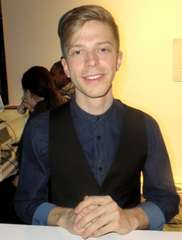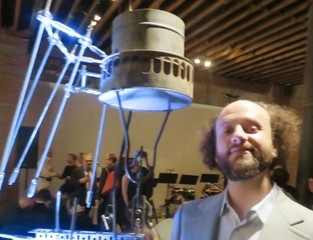|
Back
Nature Most Unnatural New York
Pioneer Works, Red Hook, Brooklyn, New York
02/11/2016 - & February 12, 2016 (Tivoli, NY)
“Laws of Nature”
Anna Thorvaldsdottir Streaming Arhythmia
Kate Moore: Days and Nature (US premiere, with sound sculpture by Eric Farber)
Fjóla Evans: NÓTT (World premiere)
Joanna Newsom: Sawdust and Diamonds (World premiere of arrangement by Dylan Mattingly)
Contemporaneous: Lucy Dhegrae, Finnegan Shanahan (Voices), Isabel Gleicher (Flute, Bass Flute), Kemp Jernigan (Oboe), Lian Kinson (Clarinet, Bass Clarinet), David Kochersberger: (Saxophone, Clarinet), Allison Nicotera (Bassoon, Contrabassoon), Cameron West (Horn), Evan Honse (Trumpet), Ric Becker (Trombone), Andrew Madej (Tuba), Matt Evans, Amy Garapic (Percussion), Milena Gligić (Piano), Colin Davin (Mandolin), Kate Dreyfuss, Josh Henderson, Sabina Torosjan, Finnegan Shanahan (Violins), Sarah Haines, Nicole Wright (Violas), Mitch Lyon (Cello), Pat Swoboda (Contrabass, Electric Bass), Tristan Kasten-Krause (Contrabass), Dylan Mattingly (Cello, Co-Artistic Director), David Bloom (Conductor, Co-Artistic Director)

D. Bloom (© Samuel A. Dog)
“Laws of Nature”, the oxymoronic title of this concert, should have been called “Flaws of Nature”. Metaphysicians, meteorologists and musicians understand that “natural” “laws” are illusory, volatile and aleatory, respectively. And the four composers who used the paradox of nature as their background, were equally aware of that.
Nature, to Messrs Thorvaldsdottir, Newsom, Moore and Evans could be the metamorphosis of a dream or the growth of a tree or the voice of a poem, or in the case of Ms. Anna Thorvaldsdottir (the only composer who I had heard previously), “the balance between tranquility and disruption.”
All four works were conducted by David Bloom, the co-Artistic Director of Contemporaneous. That group could hardly be called a chamber ensemble. It’s a chamber orchestra, with up to 30 splendid musicians. And their venue last night was a most “unnatural” setting. Red Hook in Brooklyn was the first Dutch settlement outside Manhattan, though nothing gives indication of its origins. The subway station is far from Pioneer Works, the large gallery on the far end of a small dark street. Getting there meant getting lost a few times, but inside the tiny door, one came upon a vast art gallery, with a fine setting for this concert.
(Fine except that the slightest flicker of a program from the audience was echoed onto the stage. But this was a minor inconvenience.)
The evening started with Ms. Thorvaldsdottir ’s Arhythmia, and like all her works, the moods evolved and devolved, offering a strange sensation of being off-balance (like the title) or part of a whole unified ensemble.
She began with low double-bass humming, intercepted by quick notes from solo instruments. Where were they going? Ms. Thorvaldsdottir knew, for the notes became more frequent, they joined together, they coalesced into the whole Contemporaneous ensemble playing a grand spectacle, falling back to those droning notes and a different configuration of the opening short notes.
Like each of the works last night, it had the substance of a dream: within the orchestra, all seemed rational, but to us, there was a scary, almost chaotic sense that we didn’t even understand what was coming next.

E. Farber (© Samuel A. Dog)
That, though, was not the case of the following Days and Nature by the Australian-born Kate Moore. The feature here was a metallic structure at the back of the audience (actually only 10-odd feet behind). The structure by percussionist-sound-artist Eric Farber had a consciously clunky look to it, with a top that, with some facial characteristics, would look like Robby the Robot.
Mr. Farber stayed silent for the first half of the work. Unlike the music of Ms.. Thorvaldsdottir, this start was almost familiar. A whole whirligig of canons played by the entire ensemble, though essentially in the strings. This was a sound tapestry, which could have illustrated water motions. As the music went forward, one or another instrument would indicate another very simple pattern, and the other instruments followed, as a wave climbing higher and higher, with a wavelet behind ready to overpower the first.
One thought immediately of Stephen Reich’s music, but when Mr. Farber began running his clackety-clack “instrument”, Ms Moore began a brilliant unsubtle climax with an intensive climax with brass and percussion taking control from the fungible fluidity, Evan Honse’s trumpet reached up to a Bach-trumpet high note with the other brass trilling and the trombone glissando, and the sound-structure buzzing from the outside...
One felt this was like chamber-orchestra Bruckner! All the elements of the Bruckner finales reaching higher and higher. A quite extraordinary ending.
After the intermission, two “vocal” pieces completed the concert, both with soloists who transcended the music itself.
Icelandic-Canadian composer Fjóla Evans wrote about dreams using the Norse God of Sleep, NÓTT (commissioned by Contemporaneous) as her title. The ensemble was an eddy of notes which segued between different sections. But it was the voice of Lucy Dhegrae which rose above everything. Hers was a vocalise, with lulling sounds rather than words. She sung, yes. But hers was a soprano-alto which almost literally melted through the sounds of the orchestra.
I have no doubt Ms. Dhegrae can essay those tours de force which all singers do these days. Yet this was a voice which didn’t need gymnastics. The sounds were pure, sweet, Ms. Evans’s semi-melodies seemed to come out of space, floated, evaporated, started again. It was an experience which transcended the composition itself.
The final work was based on a very complex poem, and was sung by a multi-instrumentalist, composer and gently appealing singer, Finnegan Shanahan. I had never heard (or heard of) him, but he is quite famed in young compositional circles, and he sung Joanna Newsom’s Sawdust and Diamonds (Contemporaneous-commissioned world premiere arrangement by Dylan Mattingly) with a steady pure voice.
In this case, the music was fairly strophic, the melodies repeating themselves with slight alterations. The music with its rippling bell-like texture changed during the work. But Mr. Shanahan’s voice, the complex yet fiercely emotional poem, and the hypnotic repeats of the melody again offered a dreamscape to the evening.
Nothing even hinted at the thematic “Laws of Nature”, but that was fine. Aristotle once said that “of all things that exist, some are from nature, some are from other causes.” He never attempted to describe those “others.” Maybe only music can draw out its non-verbal substance.
Harry Rolnick
|